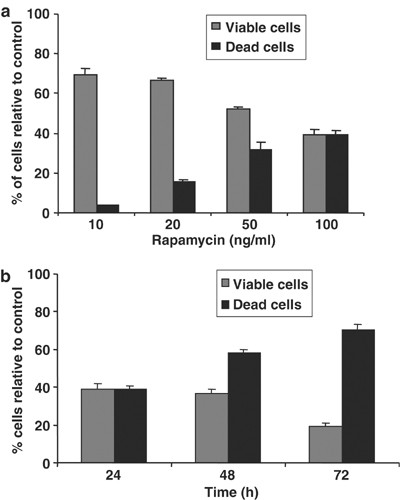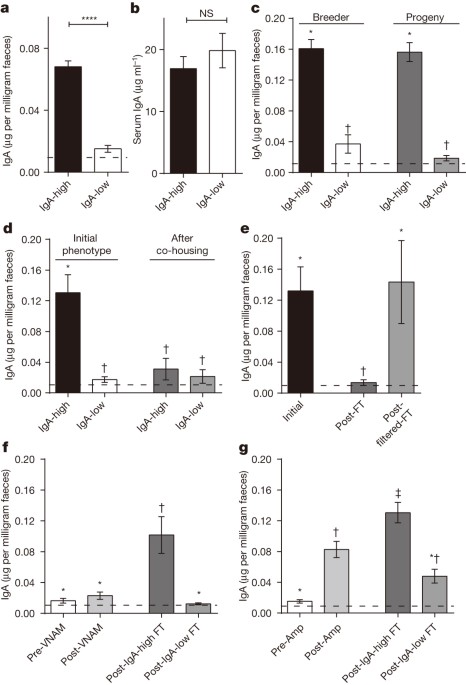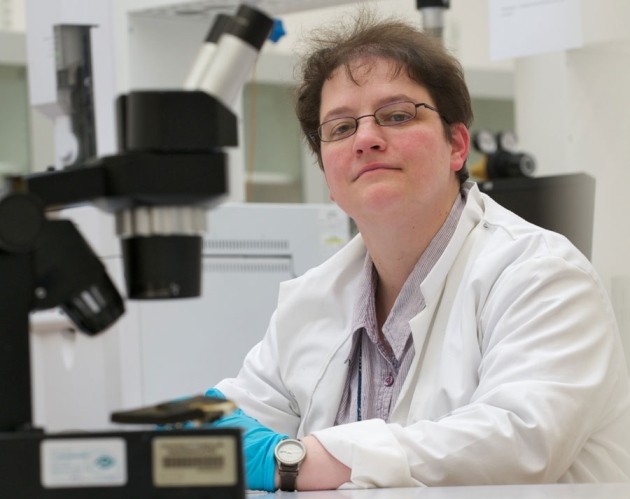
- Select a language for the TTS:
- UK English Female
- UK English Male
- US English Female
- US English Male
- Australian Female
- Australian Male
- Language selected: (auto detect) - EN
Play all audios:
ABSTRACT Rapamycin, a complex macrolide and potent fungicide, immunosuppressant and anticancer agent, is a highly specific inhibitor of mammalian target of rapamycin (mTOR). Rapamycin has
been shown to induce G1-phase cell cycle arrest in diverse tumor cell types, and its derivatives RAD001 and CCI-779 are currently in phase I and phase II clinical trials, respectively, as
anticancer agents. In this study, we show that rapamycin induced the apoptotic death of JN-DSRCT-1 cells, the only available _in vitro_ model for Desmoplastic Small Round Cell Tumors
(DSRCT), while having only minor effects on their cell cycle. Rapamycin induced apoptosis by increasing the Bax : Bcl-xL ratio as a consequence of the concomitant downregulation of Bcl-xL
and upregulation of Bax, both at the post-transcriptional level. Rapamycin also downregulated the levels of EWS/WT1, the fusion protein characteristic of DSRCT. Transient transfection
studies using kinase-dead and rapamycin-resistant forms of mTOR demonstrated that only the downregulation of Bcl-xL was caused by the mTOR inhibitory action of rapamycin, which prevented
cap-dependent translation initiation, whereas Bax upregulation was induced by rapamycin through a mechanism independent of its mTOR inhibitory activity. Moreover, rapamycin treatment
downregulated the mRNA and protein levels of the _26S p44.5_ proteasome subunit, suggesting the involvement of the proteasome complex in the mechanisms of rapamycin-induced apoptosis.
Treatment of JN-DSRCT-1 cells with MG-132, a proteasome specific inhibitor, also resulted in the induction of apoptosis through a similar increase in the Bax : Bcl-xL ratio specifically
caused by inhibiting Bax degradation and turnover. These results suggested that rapamycin induces apoptosis by preventing the degradation of the Bax protein by the proteasome, and that this
process is independent of mTOR inhibition. Furthermore, these results strongly support the introduction of the use of rapamycin as a cytotoxic agent for the treatment of DSRCT. Access
through your institution Buy or subscribe This is a preview of subscription content, access via your institution ACCESS OPTIONS Access through your institution Subscribe to this journal
Receive 50 print issues and online access $259.00 per year only $5.18 per issue Learn more Buy this article * Purchase on SpringerLink * Instant access to full article PDF Buy now Prices may
be subject to local taxes which are calculated during checkout ADDITIONAL ACCESS OPTIONS: * Log in * Learn about institutional subscriptions * Read our FAQs * Contact customer support
SIMILAR CONTENT BEING VIEWED BY OTHERS DEPLETION OF SURVIVIN SUPPRESSES DOCETAXEL-INDUCED APOPTOSIS IN HELA CELLS BY FACILITATING MITOTIC SLIPPAGE Article Open access 27 January 2021
VELCRIN-INDUCED SELECTIVE CLEAVAGE OF TRNALEU(TAA) BY SLFN12 CAUSES CANCER CELL DEATH Article 27 October 2022 TCTP PROTEIN DEGRADATION BY TARGETING MTORC1 AND SIGNALING THROUGH S6K, AKT, AND
PLK1 SENSITIZES LUNG CANCER CELLS TO DNA-DAMAGING DRUGS Article Open access 21 October 2021 REFERENCES * Aranha O, Grignon R, Fernandes N, McDonnell TJ, Wood Jr DP and Sarkar FH . (2003).
_Int. J. Oncol._, 22, 787–794. * Bertolotti A, Lutz Y, Heard DJ, Chambon P and Tora L . (1996). _EMBO J._, 15, 5022–5031. * Biegel JA, Conard K and Brooks JJ . (1993). _Genes Chromosomes
Cancer_, 7, 119–121. * Bierer BE, Mattila PS, Standaert RF, Herzenberg LA, Burakoff SJ, Crabtree G and Schreiber SL . (1990). _Proc. Natl. Acad. Sci. USA_, 87, 9231–9235. * Bjornsti MA and
Houghton PJ . (2004). _Cancer Cell_, 5, 519–523. * Brunn GJ, Hudson CC, Sekulic A, Williams JM, Hosoi H, Houghton PJ, Lawrence Jr JC and Abraham RT . (1997). _Science_, 277, 99–101. * Chang
YC, Lee YS, Tejima T, Tanaka K, Omura S, Heintz NH, Mitsui Y and Magae J . (1998). _Cell Growth Differ._, 9, 79–84. * Chung J, Kuo CJ, Crabtree GR and Blenis J . (1992). _Cell_, 69,
1227–1236. * Coenen Schimke JM, Ljungqvist OH, Sarkar G, Conover CA and Sreekumaran Nair K . (1999). _Growth Horm. IGF Res._, 9, 179–186. * Cory S, Huang DC and Adams JM . (2003).
_Oncogene_, 22, 8590–8607. * Davis DL and Soldin SJ . (2000). _Biochem. Biophys. Res. Commun._, 277, 325–329. * Delattre O, Zucman J, Plougastel B, Desmaze C, Melot T, Peter M, Kovar H,
Joubert I, de Jong P, Rouleau G, Aurias A and Thomas G . (1992). _Nature_, 359, 162–165. * Erbay E, Park IH, Nuzzi PD, Schoenherr CJ and Chen J . (2003). _J. Cell Biol._, 163, 931–936. *
Frost P, Moatomed F, Hoang B, Shi Y, Gera J, Yan H, Frost P, Gibbons J and Lichtenstein A . (2004). _Blood_, 104, 4181–4187. * Geoerger B, Kerr K, Tang CB, Fung KM, Powell B, Sutton LN,
Phillips PC and Janss AJ . (2001). _Cancer Res._, 61, 1527–1532. * Gerald WL, Rosai J and Ladanyi M . (1995). _Proc. Natl. Acad. Sci. USA_, 92, 1028–1032. * Gingras AC, Gygi S, Raught B,
Polakiewicz RD, Abraham RT, Hoekstra MF, Aebersold R and Sonenberg N . (1999). _Genes Dev._, 13, 1422–1437. * Grolleau A, Bowman J, Pradet-Balade B, Puravs E, Hanash S, Garcia-Sanz JA and
Beretta L . (2002). _J. Biol. Chem._, 277, 22175–22184. * Guba M, von Breitenbuch P, Steinbauer M, Koehl G, Flegel S, Hornung M, Bruns CJ, Zuelke C, Farkas S, Anthuber M, Jauch KW and
Geissler EK . (2002). _Nat. Med._, 8, 128–135. * Hleb M, Murphy S, Wagner EF, Hanna NN, Sharma N, Park J, Li XC, Strom TB, Padbury JF, Tseng YT and Sharma S . (2004). _J. Biol. Chem._, 279,
31948–31955. * Hosoi H, Dilling MB, Shikata T, Liu LN, Shu L, Ashmun RA, Germain GS, Abraham RT and Houghton PJ . (1999). _Cancer Res._, 59, 886–894. * Huang S, Bjomsti MA and Houghton PJ .
(2003). _Cancer Biol. Ther._, 2, 222–232. * Huang S and Houghton PJ . (2001). _Drug Resist. Update_, 6, 378–391. * Huang S and Houghton PJ . (2002). _Curr. Opin. Investig. Drugs_, 3,
295–304. * Iiboshi Y, Papst PJ, Kawasome H, Hosoi H, Abraham RT, Houghton PJ and Terada N . (1998). _J. Biol. Chem._, 274, 1092–1099. * Ito E, Honma R, Imai J, Azuma S, Kanno T, Mori S,
Yoshie O, Nishio J, Iwasaki H, Yoshida K, Gohda J, Inoue J, Watanabe S and Semba K . (2003). _Am. J. Pathol._, 163, 2165–2172. * Kim J, Lee K and Pelletier J . (1998a). _Oncogene_, 16,
1021–1030. * Kim J, Lee K and Pelletier J . (1998b). _Oncogene_, 16, 1973–1979. * Ladanyi M and Gerald WL . (1994). _Cancer Res._, 54, 2837–2840. * Lebedeva IV, Su ZZ, Chang Y, Kitada S,
Reed JC and Fisher PB . (2002). _Oncogene_, 21, 708–718. * Lee SB and Haber DA . (2001). _Exp. Cell Res._, 264, 74–99. * Li S, Takasu T, Perlman DM, Peterson MS, Burrichter D, Avdulov S,
Bitterman PB and Polunovsky VA . (2003). _J. Biol. Chem._, 278, 3015–3022. * Lin TA, Kong X, Haystead TA, Pause A, Belsham G, Sonenberg N and Lawrence Jr JC . (1994). _Science_, 266,
653–656. * Liu FT, Goff LK, Hao JH, Newland AC and Jia L . (2004). _Apoptosis_, 9, 377–384. * Lohrum MAE and Vousden KH . (1999). _Cell Death Differ._, 6, 1162–1168. * Majumder PK, Febbo PG,
Bikoff R, Berger R, Xue Q, McMahon LM, Manola J, Brugarolas J, McDonnell TJ, Golub TR, Loda M, Lane HA and Sellers WR . (2004). _Nat. Med._, 10, 594–601. * Mateo-Lozano S, Tirado OM and
Notario V . (2003). _Oncogene_, 22, 9282–9287. * May WA, Lessnick SL, Braun BS, Klemsz M, Lewis BC, Lunsford LB, Hromas R and Denny CT . (1993). _Mol. Cell. Biol._, 13, 7393–7398. *
Mayerhofer M, Valent P, Sperr WR, Griffin JD and Sillaber C . (2002). _Blood_, 100, 3767–3775. * Mohiuddin I, Cao X, Fang B, Nishizaki M and Smythe WR . (2001). _Cancer Gene Ther._, 8,
547–554. * Nishio J, Iwasaki H, Ishiguro M, Ohjimi Y, Fujita C, Yanai F, Nibu K, Mitsudome A, Kaneko Y and Kikuchi M . (2002). _Lab. Invest._, 82, 1175–1182. * Ohno T, Ouchida M, Lee L,
Gatalica Z, Rao VN and Reddy ES . (1994). _Oncogene_, 9, 3087–3097. * Polunovsky VA, Rosenwald IB, Tan AT, White J, Chiang L, Sonenberg N and Bitterman PB . (1996). _Mol. Cell. Biol._, 16,
6573–6581. * Rauscher III FJ, Benjamin LE, Fredericks WJ and Morris JF . (1994). _Cold Spring Harb. Symp. Quant. Biol._, 59, 137–146. * Rauscher III FJ, Morris JF, Tournay OE, Cook DM and
Curran T . (1990). _Science_, 250, 1259–1262. * Sabers CJ, Martin MM, Brunn GJ, Williams JM, Dumont FJ, Wiederrecht G and Abraham RT . (1995). _J. Biol. Chem._, 270, 815–822. * Sawyer JR,
Tryka AF and Lewis JM . (1992). _Am. J. Surg. Pathol._, 16, 411–416. * Scharnhorst V, van der Eb AJ and Jochemsen AG . (2001). _Gene_, 273, 141–161. * Schoffstall B, Kataoka A, Clark AN and
Chase PB . (2005). _J. Pharmacol. Exp. Ther._, 312, 12–18. * Sekulic A, Hudson CC, Homme JL, Yin P, Otterness DM, Karnitz LM and Abraham RT . (2000). _Cancer Res._, 60, 3504–3513. * Shen WP,
Towne B and Zadeh TM . (1992). _Cancer Genet. Cytogenet._, 64, 189–191. * Tan A, Bitterman P, Sonenberg N, Peterson M and Polunovsky V . (2000). _Oncogene_, 19, 1437–1447. * Voorhees PM,
Dees EC, O'Neil B and Orlowski RZ . (2003). _Clin. Cancer Res._, 9, 6316–6325. * Wang JA, Fan S, Yuan RQ, Ma YX, Meng Q, Goldberg ID and Rosen EM . (1999). _Int. J. Radiat. Biol._, 75,
301–316. * Wang X, Omura S, Szweda LI, Yang Y, Berard J, Seminaro J and Wu J . (1997). _Eur. J. Immunol._, 27, 2781–2786. * Zhou C, Gehrig PA, Whang YE and Boggess JF . (2003). _Mol. Cancer
Ther._, 2, 789–795. Download references ACKNOWLEDGEMENTS This work was supported by US Public Health Service Grant PO1-CA74175 from the National Cancer Institute, NIH. Partial support was
also provided by the Microscopy and Imaging Macromolecular Analysis and the Flow Cytometry/Cell Sorting Shared Resources of the Vincent T Lombardi Comprehensive Cancer Center, funded through
US Public Health Service Grant 2P30-CA51008. AUTHOR INFORMATION AUTHORS AND AFFILIATIONS * Laboratory of Experimental Carcinogenesis, Department of Radiation Medicine, Georgetown University
Medical Center, Washington, DC, USA Oscar M Tirado, Silvia Mateo-Lozano & Vicente Notario Authors * Oscar M Tirado View author publications You can also search for this author inPubMed
Google Scholar * Silvia Mateo-Lozano View author publications You can also search for this author inPubMed Google Scholar * Vicente Notario View author publications You can also search for
this author inPubMed Google Scholar CORRESPONDING AUTHOR Correspondence to Vicente Notario. RIGHTS AND PERMISSIONS Reprints and permissions ABOUT THIS ARTICLE CITE THIS ARTICLE Tirado, O.,
Mateo-Lozano, S. & Notario, V. Rapamycin induces apoptosis of JN-DSRCT-1 cells by increasing the Bax : Bcl-xL ratio through concurrent mechanisms dependent and independent of its mTOR
inhibitory activity. _Oncogene_ 24, 3348–3357 (2005). https://doi.org/10.1038/sj.onc.1208471 Download citation * Received: 01 November 2004 * Revised: 16 December 2004 * Accepted: 20
December 2004 * Published: 14 March 2005 * Issue Date: 05 May 2005 * DOI: https://doi.org/10.1038/sj.onc.1208471 SHARE THIS ARTICLE Anyone you share the following link with will be able to
read this content: Get shareable link Sorry, a shareable link is not currently available for this article. Copy to clipboard Provided by the Springer Nature SharedIt content-sharing
initiative KEYWORDS * apoptosis * DSRCT * EWS/WT1 * proteasome * rapamycin






